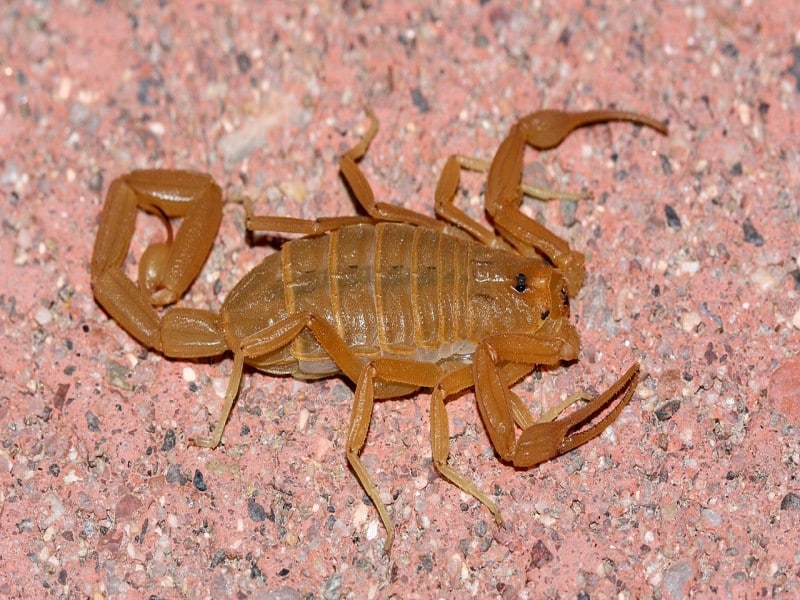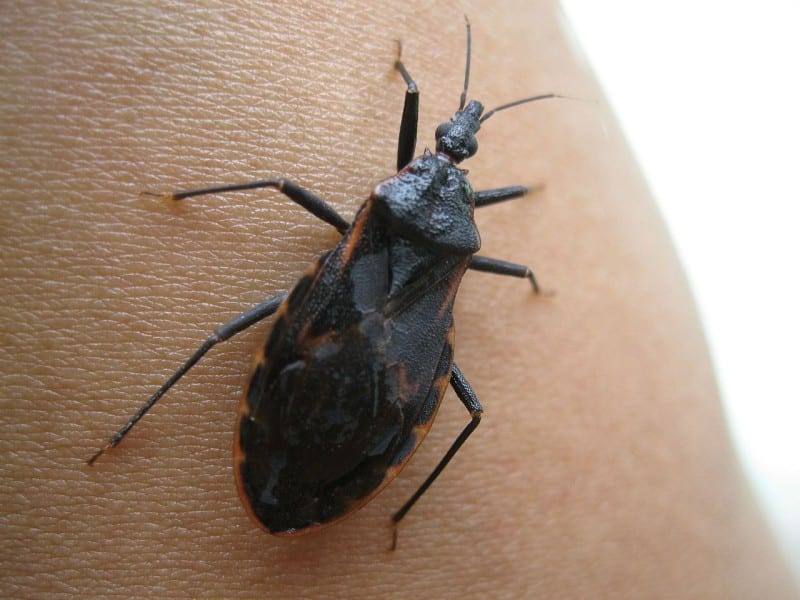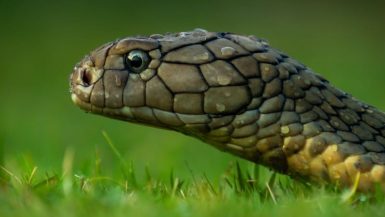
With four deserts stretching across Arizona and otherworldly landscapes presenting themselves around every corner, it’s no wonder the state is known for its dramatic terrain and even more fearsome wildlife. Naming the top dangerous animals in Arizona is no easy task.
Home to tiny creatures with a deadly bite, the infamous Africanized bee, 13 species of rattlesnakes, and powerful bears and mountain lions, no landscape is completely safe. Plus, as some of these creepy crawlers prefer the comfort of homes, knowing which to look out for is a must.
Whether you’re heading to Arizona for a visit or call the diverse state home, there are a select few creatures you’ll want to be aware of. Below, we’ve listed the top 11 dangerous animals in Arizona, and we hope you never encounter a single one.
Gila Monster

- Latin name: Heloderma suspectum
- Fatal weapon: Venom released by chewing
- Treatment: Seek medical treatment
- Where to find them: Western and Southern Arizona in scrubland, succulent desert, and oak woodland
The legend of the Gila Monster dates back to the Old West when pioneers believed the very breath of this colorful lizard could cause death. This fear was passed down through the ages, and even today, it’s commonly thought the Gila Monster is one of the most dangerous animals in Arizona.
Although the Gila Monster’s bite is venomous and can cause swelling, irritation, and difficulty breathing, the fear of the Gila Monster is largely unnecessary. Preferring to keep out of harm’s way and out of the sun, Gila Monsters hang out in burrows during the day and head out at night to hunt small mammals and feast on bird eggs. As long as you don’t leave your fingers or toes out where a Gila Monster could decide they’re a tasty snack, the chances of being bitten by one are extremely low.
Africanized Bee (Killer Bee)

- Latin name: Apis Mellifera
- Fatal Weapons: Potentially fatal sting
- Treatment: Antihistamine
- Where to find them: Across Arizona
If the name isn’t enough to put you off, the Africanized Bee is the bee of all bees. Every aspect of their behavior ensures you don’t get near their hive, and if you do, you won’t enjoy the consequences. Compared to their friendly counterparts, Africanized Bees guard their hive much more aggressively, live in much higher population densities, are much more defensive, and will pursue threats over much longer distances.
Africanized bees are now found across the Americas, from Venezuela to Arkansas and have been known to chase people a quarter of a mile. With the high numbers of bees chasing, victims receive ten times more stings compared to an attack by European honey bees. To make matters worse, the only way to tell an Africanized bee from a honey bee is to take a very close look. Their bodies are slightly smaller and have darker bands of brown compared to honey bees. It might not be one of the most dangerous animals in the world, but it’s certainly not an insect you want to come across.
Bark Scorpion

- Latin name: Centruroides sculpturatus
- Fatal Weapons: Venom
- Treatment: Basic first aid, call poison control for severe symptoms
- Where to find them: Sonoran Desert
The most common type of scorpion and the most deadly found in Arizona, the bark scorpion is undoubtedly a creepy crawler you want to steer clear of. The Bark Scorpion may look skinny and pale compared to other scorpions, but don’t let this fool you. Their bite causes severe pain, vomiting, loss of function, and numbness, among other things. On top of this, with their small body size, they’re experts at finding their way into houses and love the moisture and humidity of irrigated lawns.
Fatal bites are rare but not unheard of. Since 1968, two people have died from Bark Scorpion bites in Arizona and it’s estimated over 1000 people are bitten in Arizona and New Mexico each year. An antivenom was known to cause adverse effects, and it was discontinued in 2000. If you’re bit, clean the sting thoroughly with soap and water, apply a cool cloth and take pain medicine. If symptoms persist or worsen, seek medical attention.
Arizona Coral Snake

- Latin name: Micruroides euryxanthus
- Fatal Weapons: Venom
- Treatment: Seek immediate medical evaluation
- Where to find them: Central and southern Arizona, woodland, grassland, and farmland
What the Arizona Coral Snake lacks in size compared to other deadly snakes, it makes up for in its venom. Its venom is more than twice as potent as most rattlesnakes and causes nausea, vomiting, drowsiness, and salivation. However, due to the Arizona Coral Snake’s small mouth and little fangs, it cannot inject a lethal amount of venom into humans. Hence, its prey of choice is smaller snakes and small lizards.
Coming across an Arizona Coral Snake is also relatively uncommon. A nocturnal creature, they stay underground during the day and only come out at night. However, if you happen to see a snake with a very blunt head with red and black bands that completely encircle the body and thinner yellow or white bands, it’s best to steer clear.
Black Widow Spider

- Latin name: Latrodectus Hesperus
- Fatal Weapons: Venom
- Treatment: Standard first aid, antivenom for severe symptoms
- Where to find them: Across Arizona, in dark and secluded areas
Considered the most venomous spider in North America, the Black Widow Spider (especially the female) is one you hope doesn’t crawl your way. If you thought the Arizona Coral Spider sounded unpleasant with venom twice as potent as a rattlesnake, the Black Widow Spider’s venom is thought to be 15 times more toxic.
If you’re bitten, you’ll suffer from pain, nausea, and localized sweating. However, fatal bites are extremely rare and have only been documented in the very young, very old, and those with severe underlying health issues. Even so, keep an eye out for spiders with a red or yellow hourglass mark on their bellies, often hanging out in dark crevices and secluded corners of the house or basement.
Sonoran Desert Toad

- Latin name: Incilius alvarius
- Fatal Weapons: Poisonous toxins
- Treatment: Flush affected areas immediately with running water
- Where to find them: Southern Arizona, in desert and semi-arid areas
Unlike the other most dangerous animals in Arizona, the Sonoran Desert Toad is not venomous. Instead, this toad has glands in its skin that produce poisonous toxins. When ingested, symptoms include an irregular heartbeat and excessive salivation. However, unless you’re on the hunt for your prince charming or handle the frog excessively, it’s rare for humans to suffer from Sonoran Desert Toad toxins. Dogs are the most common victims, and its poison is strong enough to be fatal to even large dogs.
As the Sonoran Desert Toad’s glands also produce bufotenin, a hallucinogenic, you need a fishing license just to be able to catch the toad. In other states, it’s illegal to have the toad in your possession for any reason, so to be on the safe side both legally and safety-wise, it’s best to leave these hoppers alone.
Banded Desert Centipede

- Latin name: Scolopendra polymorpha
- Fatal Weapons: Venom
- Treatment: First aid and pain killers, seek medical advice if symptoms worsen or persist
- Where to find them: Dry grasslands, forest, and desert
Reaching up to 7 inches (18 cm) in length, even the look of these creepy crawlers is likely to send goosebumps down your spine. They prefer to dine on insects, lizards, and small rodents. However, if you get too close and they deem you a potential predator, you may become subject to their excruciating sting. Top this with potentially fatal venom, and you have the Banded Desert Centipede rightly fit for nightmares.
It’s rare for the Branded Desert Centipede’s sting to be fatal, but with harsh symptoms including nausea, heart palpitations, and local tissue damage, it’s not a creature you want to tempt fate with. Luckily, it’s rare for Branded Desert Centipedes to come out during the day and prefer to hide under rocks. Keep your shoes on, don’t go kicking rocks, and you should be in the clear
Mojave Rattlesnake

- Latin name: Crotalus scutulatus
- Fatal Weapons: Venom
- Treatment: Immediate antivenom
- Where to find them: Scrub brush in high desert or lower mountain slopes
Without the highly effective antivenom, Mojave Rattlesnakes could easily top the list of the most dangerous animals in Arizona as well as Mexico, Utah and Nevada. The Mojave Rattlesnake’s fangs contain what’s considered the most potent of all rattlesnake venoms, and a bite can cause vision problems, difficulty breathing, nausea, and weakness. It can lead to death if left untreated.
On top of this, Mojave Rattlesnakes are considered to be one of the more aggressive rattlesnakes. Although, this comes down more to the fact they’re highly defensive if they feel threatened, rather than attacking undisturbed. If you hear the classic buzzing sound of a rattlesnake’s tail and notice a brown to pale green snake with a large triangular head, don’t take a closer look before backing away. Arizona might be home to 12 other species of rattlesnakes too, but there are few you’d want to let near you.
Black Bear

- Latin name: Ursus americanus
- Fatal Weapons: Powerful arms, paws, and jaws
- Treatment: Seek medical treatment
- Where to find them: Higher elevations of Tonto National Forest
Unlike the other creepy crawlers on this list, the Black Bear and Arizona’s vast desert landscape don’t quite go hand in hand and are likely far from your mind when you think of the most dangerous animals in Arizona. However, if you’re visiting Tonto National Forest, you may just stumble across one of these mighty creatures – especially if you’re camping with delicious smelling food.
Bear attacks in Arizona are rare, but if you’re out hiking or camping, you should always know what to do should you cross paths with a Black Bear. Firstly, don’t cross paths with a bear and instead alter your route, make loud noises such as yelling or whistling, and give the bear a chance to leave the area. If the bear doesn’t leave, stay calm and back away while facing the bear.
Tarantula Hawk

- Latin name: Pompilidae pepsini
- Fatal Weapons: Painful sting
- Treatment: Clean sting, seek immediate medical advice if sting triggers an allergic reaction
- Where to find them: Desert areas of Arizona
Neither a tarantula nor a hawk, the Tarantula Hawk, is an aggressive stinging wasp. Its sting, described as causing excruciating and unrelenting pain, tops the Schmidt sting pain rating index – meaning it makes a fire ant sting feel like a gentle poke. Fortunately, after five minutes of agony, the pain will subdue, and you’ll only be left with a small sting mark.
On rare occasions, people have been known to suffer allergic reactions and, if left untreated, can lead to death. Thus, making them a great contender as one of the most dangerous animals in Arizona. As Tarantula Hawk’s prey on tarantulas, be extra aware in dry, arid areas where tarantulas like to hang out such as the Grand Canyon.
Conenose Bug

- Latin name: Reduviidae Triatominae
- Fatal Weapons: Carriers of parasitic disease
- Treatment: Clean area of the bite and keep watch for swelling or infection
- Where to find them: Sheltered areas, especially in homes and wooden areas
Conenose Bugs, also known as Kissing Bugs, are not overly dangerous. Yet, they still make the list of the most dangerous animals in Arizona because they are known to carry deadly parasitic diseases. Similar to bed bugs, they’ll inject an anesthetic and attack while you’re asleep, so you won’t even know you’ve been bitten until they’re long gone. You’ll wake up with a headache, body aches, fatigue, and the tell-tale sign of a rash.
Just one bite is nothing to worry about besides calling in sick for the day. However, repeated bites can cause a severe allergic reaction and require medical attention. These tricksters also spend most of the day hiding and come out at night in search of food, making it hard to know they’re around until you’ve woken up with a bite.
What is the most dangerous animal in Arizona?
Rattlesnakes top the list of the most dangerous animals in Arizona. 13 species call Arizona home, and an average of 150 people are bitten each year. While death by rattlesnake bites is rare, their venom can cause severe tissue damage and other complications.
Are there deadly scorpions in Arizona?
Yes, the Bark Scorpion is found in Arizona, and on rare occasions, its sting can be fatal. Most stings cause severe pain, vomiting, loss of function, and numbness. However, healthy children and adults should recover quickly.
Are there dangerous snakes in Arizona?
Yes, Arizona is home to several dangerous snakes, including 13 different species of rattlesnakes. The Mojave Rattlesnakes are especially dangerous, and their bite can cause vision problems, difficulty breathing, nausea, weakness and can lead to death if left untreated.


